Summary
One of the ecological effects of human fishing is to change the distribution of prey animals in the food web. Some evidence suggests that harvesting of big predatory fish may increase populations of smaller forage fish and decrease zooplankton populations. Meanwhile, harvesting forage fish directly (to eat as sardines/anchovies or to feed to farmed fish, pigs, or chickens) should tend to decrease forage-fish populations and increase zooplankton populations. On the other hand, it may also be that harvesting more fish reduces total fish biomass in the ocean, without significantly increasing smaller fish populations. There are many other trends that might be observed, and generalization is difficult.
Introduction
This piece discusses how the distribution of populations and biomass of fish change in response to human fishing.
If we think the sentience of a fish scales linearly in its mass, then the total biomass of a fish population is a reasonable approximation to the total amount of suffering it contains, ignoring the fact that smaller fish probably suffer more per year due to higher infant mortality and shorter lifespans per individual. For a more detailed examination of suffering by trophic level (TL), see "Which Marine Trophic Level Contains the Most Total Suffering?".
Trophic cascades
One of the reasons it's fiendishly difficult to evaluate the overall impact of fishing on wild-animal suffering is that most of the fish that people catch are predators. Marine ecosystems have many layers of predation. For example, one potential pathway up the food chain is the following, where "<‑‑" means "is eaten by":
sunlight + nutrients <‑‑ phytoplankton <‑‑ zooplankton <‑‑ herring <‑‑ tuna <‑‑ sharks.
Following the logic of "the enemy of my enemy is my friend", the idea of trophic cascades posits that "the predator of my predator is my friend".
There are many examples of this trend in fish food chains. For example, the decline of sharks in the north Atlantic allowed for an increase in cownose rays, which then ate many more scallops.
Trophic simulations
Pages 28-29 of this paper show simulation results for the effect of fishing. Following is a "bottom-up ecosystem", where the biomass distribution is based only on energy transfer up trophic levels. Note that a TL of 1 corresponds to primary production and microbial biomass recycling, while TL 2 corresponds to herbivores and detritivores.
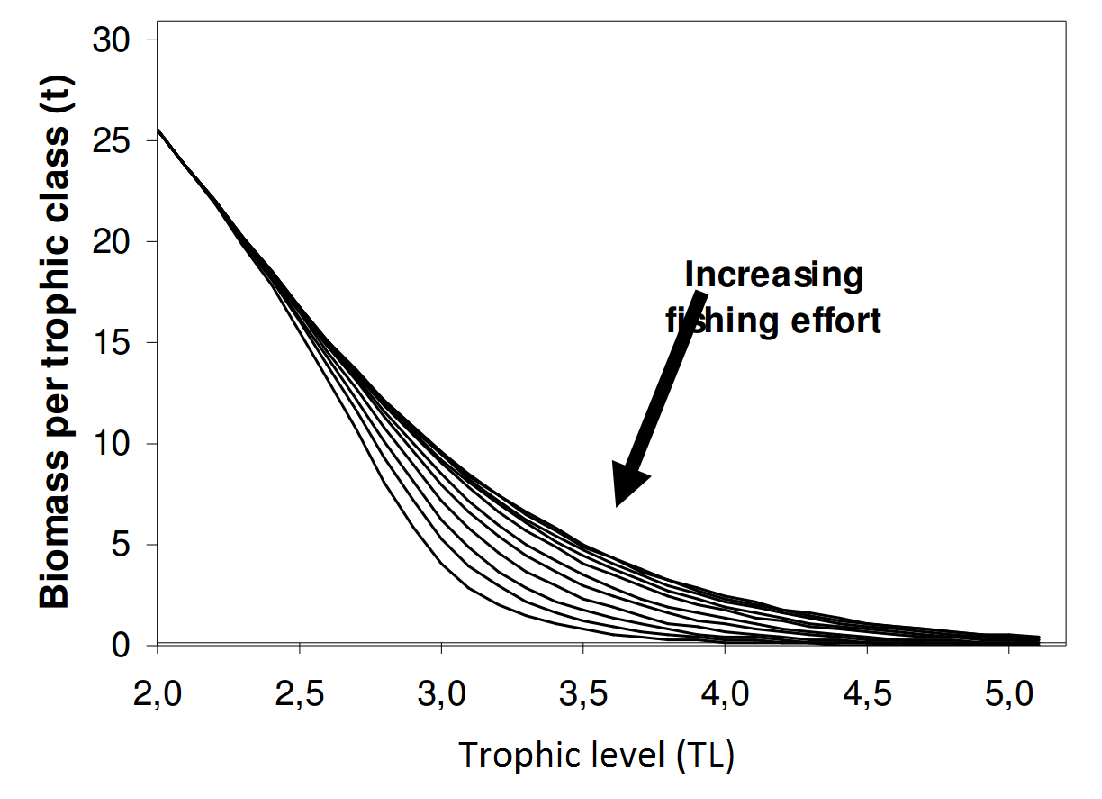
Fishing has the most impact on top predators because they're caught directly and face lower prey populations.
And here's a "top-down ecosystem" where the model specifies that prey abundance decreases as predators increase:
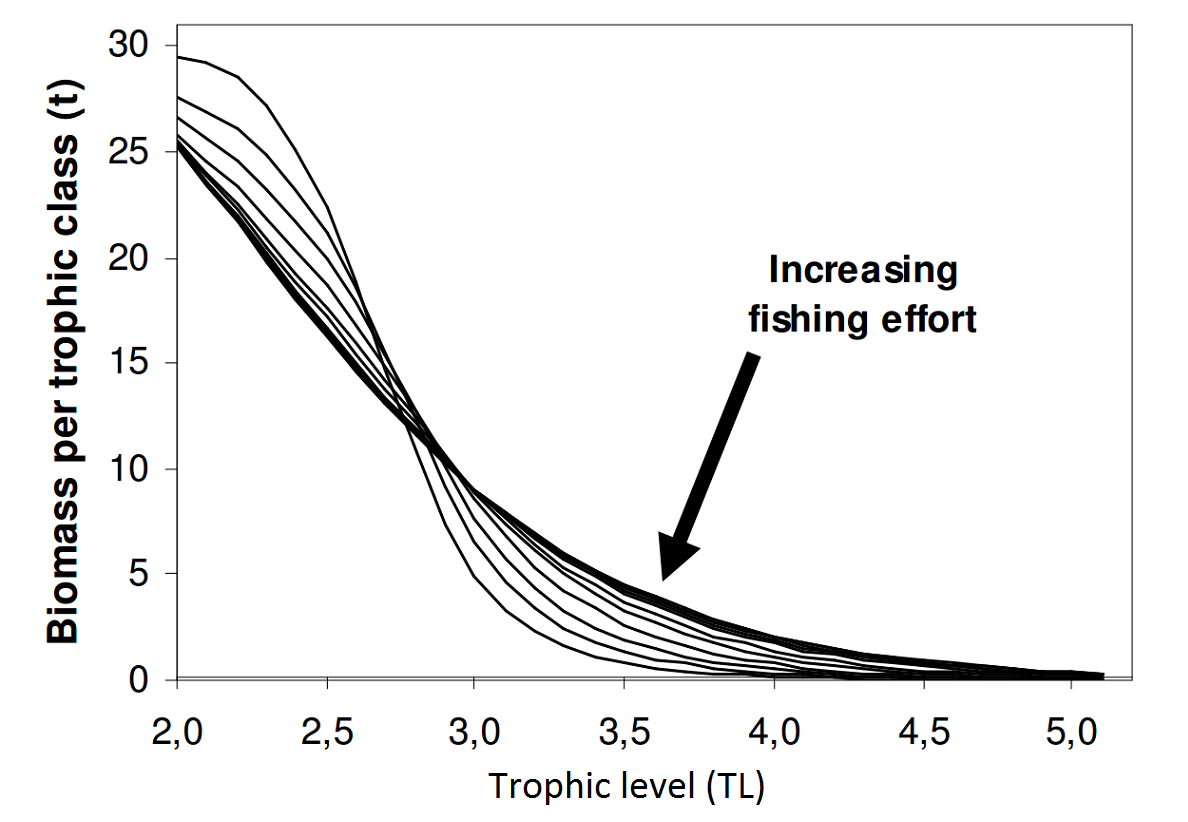
Here the prey are released from predation and so may actually increase in numbers with more fishing.
Finally, the following two graphs show a top-down ecosystem depending on which trophic levels are fished. If only top predator fish are caught, the effect can be a trophic cascade as shown in the first figure below (low top predators, high medium predators, low bottom fish). If instead all trophic levels of fish are caught, then the distribution is as shown in the second figure below, where fishing at middle/lower trophic levels roughly balances out the effect of mesopredator release.
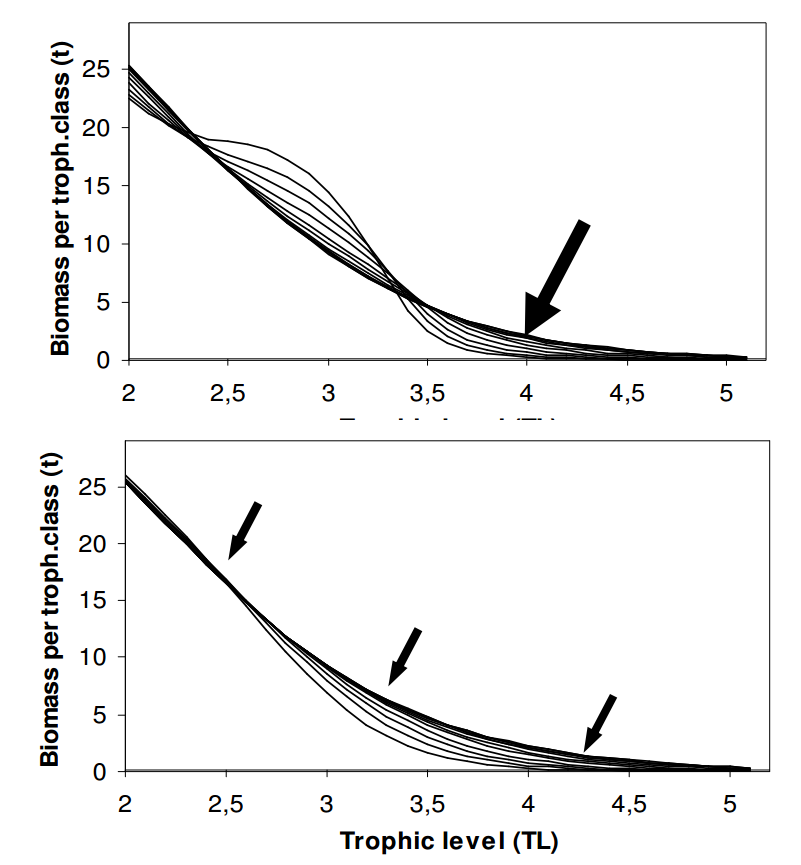
Guinean shelf ecosystem
Gascuel et al., 2011
This paper includes the following figure showing the impact of fishing on the Guinean shelf ecosystem according to two different models (CTSA and Ecopath):
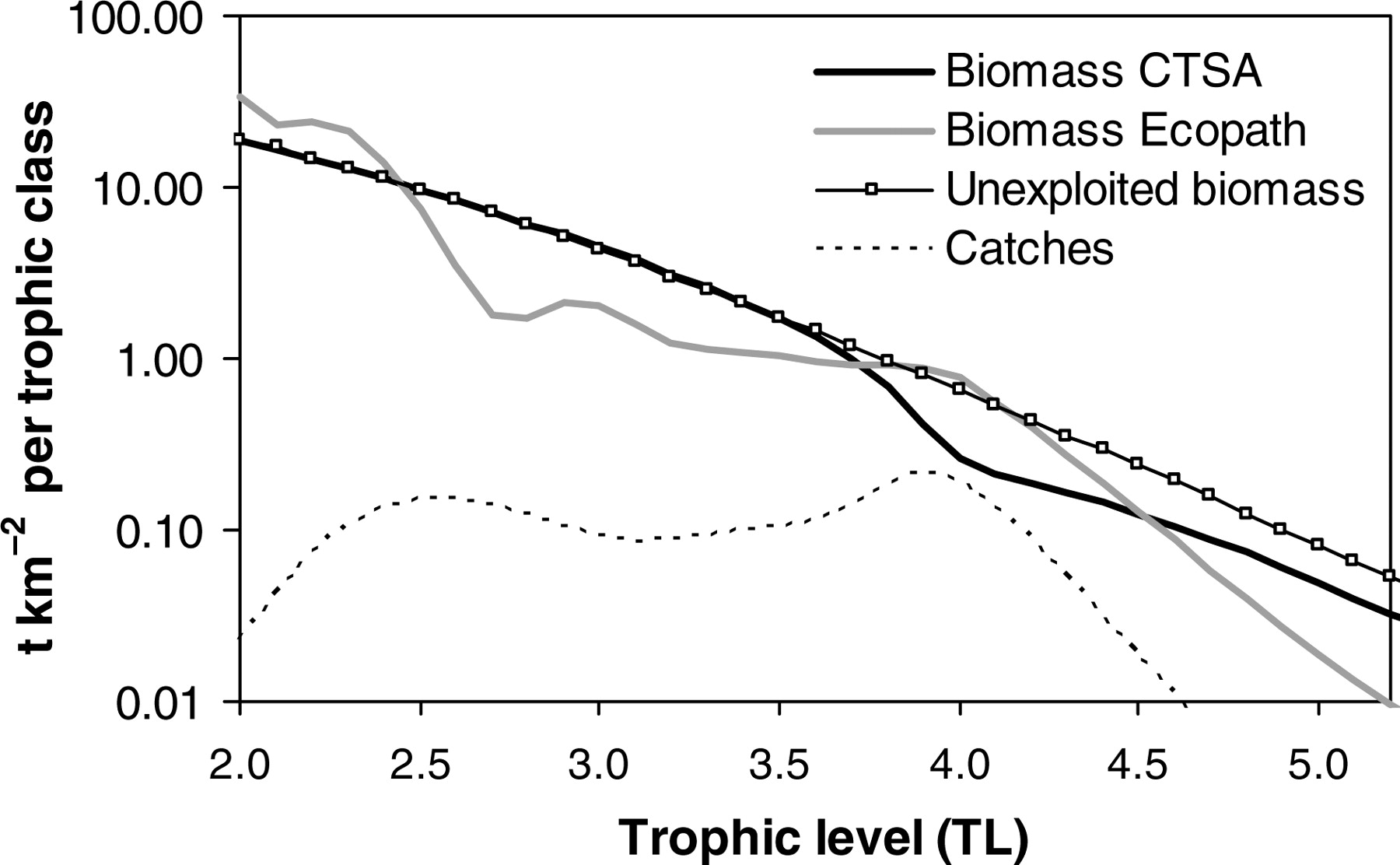
CTSA seems to suggest only reductions in biomass, while Ecopath suggests some increases, especially at the low trophic levels. Note that because the y axis is logarithmic, the apparently small increase in biomass at low trophic levels for the Ecopath curve is actually quite significant. To better visualize this fact, I created a non-log-scale version of the above graph (just for the Ecopath model) by eyeballing approximate values from the log graph. My readings of the log graph weren't perfect but at least capture the main point.
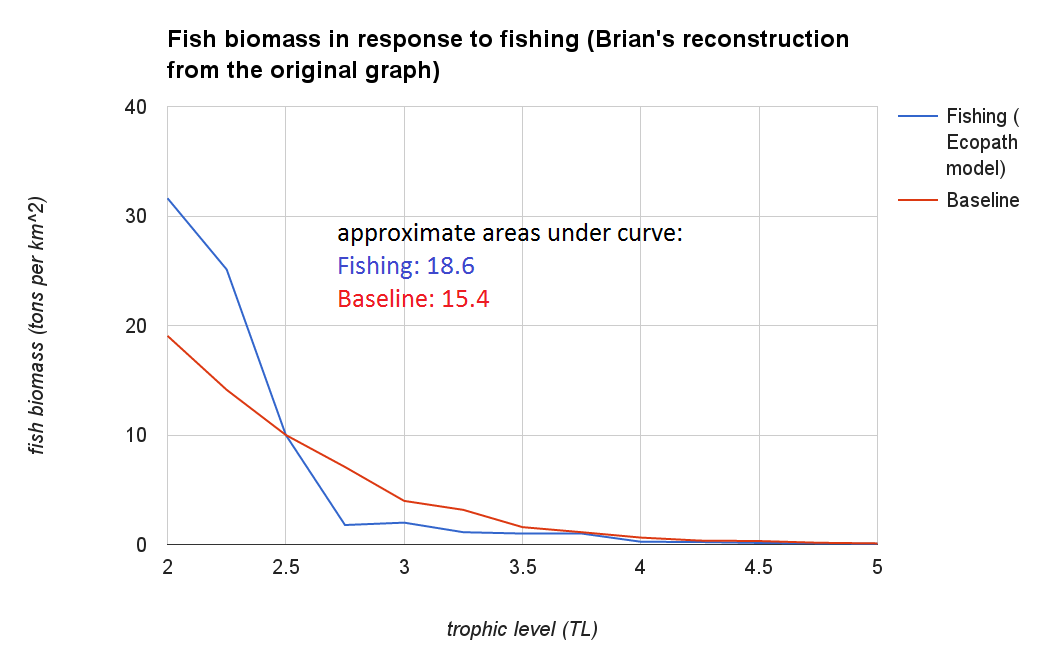
The areas under the two curves are approximately on par, which suggests that fishing doesn't decrease total biomass under the Ecopath model.
Gasche and Gascuel, 2013
This paper also looked at the Guinean ecosystem using the EcoTroph model. It found that
Total animal biomass (TL ≥ 2) is currently ~146.4 t km−2, while it is estimated at ~149.8 t km−2 without any fishing. Thus it is little affected by fishing, as it mostly consists of unexploited low TL species such as zooplankton or benthos. [...]
Current biomass accessible to fisheries is equal to 11.3 t km−2 and was estimated to be equal to 18.7 t km−2 in the unexploited state [...].
This ecosystem does not appear to be globally overexploited, but the fraction that is accessible to fisheries has undoubtfully been strongly modified by fishing, in terms of biomass as well as TL.
The authors found that industrial fishing (mainly from foreign fleets) took higher trophic-level fish compared against smaller-scale artisanal fisherpeople, who took lower trophic-level fish too.
Benguela ecosystem
This paper simulated two scenarios for increased fishing effort in the Southern Benguela ecosystem:
(i) a doubling in the fishing mortality of three small pelagic species (anchovy, sardine, and redeye at TLs 3.54, 2.99, and 3.64, respectively) and (ii) a doubling in the fishing mortality of the two groups of hake (TL = 4.50 for Deep-water Cape hake and TL = 4.64 for Cape hake) of the ecosystem. These scenarios aim at better understanding of key ecosystem dynamics and do not correspond to realistic management options given the current state of the ecosystem.
The impact on biomass is shown below, where the first two figures represent scenario (i) without and then with merging of trophic levels in the graph, and the third figure shows scenario (ii). "Simulated B" means predicted biomass with increased fishing of the target species, and "Initial B" means baseline biomass. Ecosim, Osmose, and EcoTroph are three different modeling tools that are being compared.
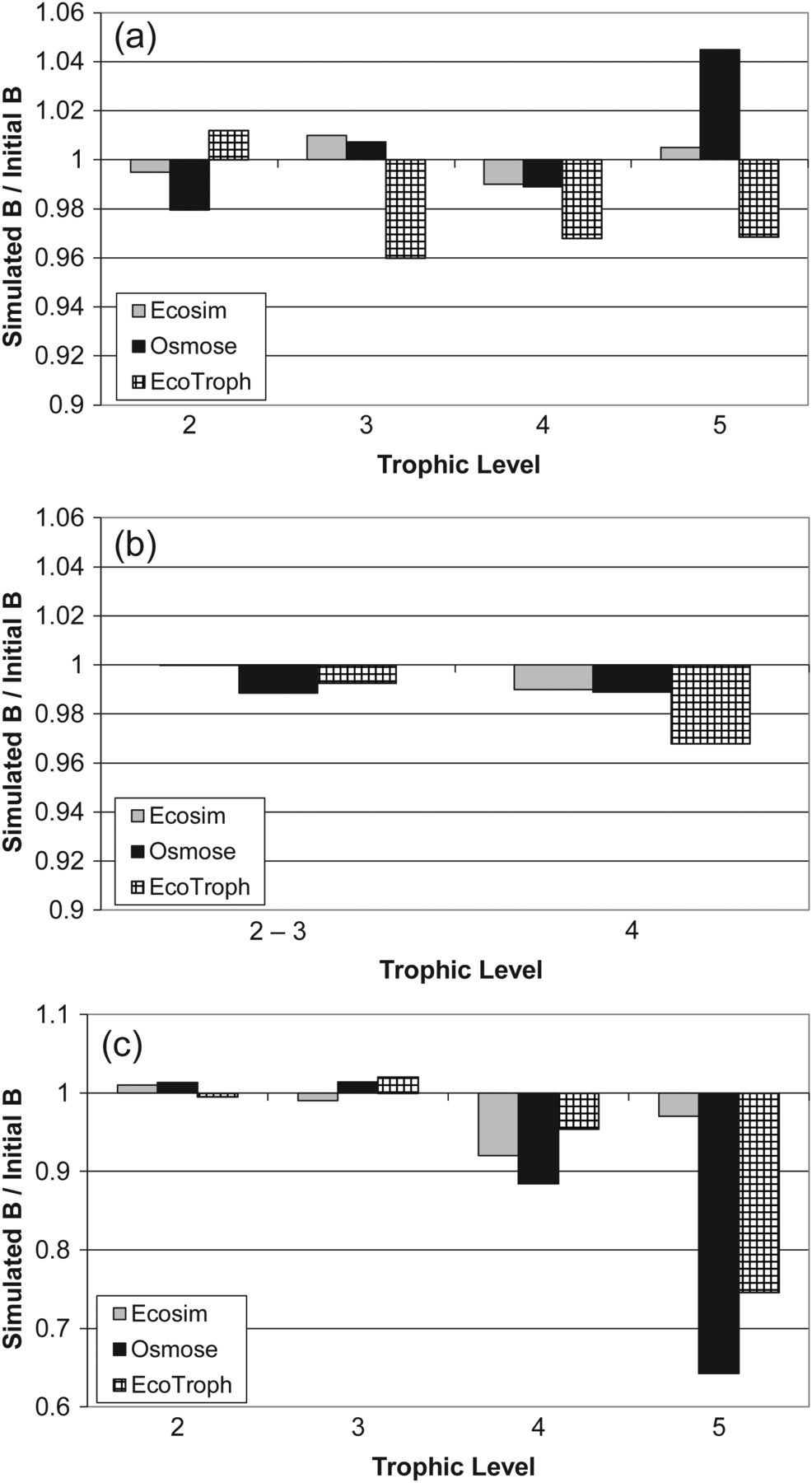
The results show trophic-cascade effects and suggest that the net impact of fishing on total fish biomass is not obvious.
The paper also notes that
A general result from our models was that low TL species are key species in the sense that they greatly influence their ecosystem through predator–prey relationships. These results seem consistent with those of previous studies by Cury et al. (2000) and Shannon et al. (2009), and raise one of the most important problems [or, if you favor lower biomass to reduce suffering, important solutions!] of the exploitation of low TL species: it may provide high catches but impacts the whole food chain, reducing the biomass of predators even if they are not directly targeted.
Empirical findings
The above simulations offer a range of possible dynamics for how fish ecosystems may respond to fishing pressure. But which of them is most accurate? Probably the answer varies from case to case, but following are some examples of real-world findings.
Central Baltic Sea trophic cascade
One study found that overfishing, combined with other environmental changes, reduced cod populations, which increased populations of its prey sprat, which decreased populations of its copepod prey (Pseudocalanus acuspes):

Increase in sardines and other small fish
Another study found a trend that can be represented as follows:
| Trophic level | Population change due to overfishing | Change in suffering for that trophic level |
| Big fish | ↓ | decrease |
| Small fish | ↑ | increase |
| Zooplankton | ↓ | decrease |
| Phytoplankton and bacterial decomposers | ↑ | increase |
A naive reading of this table is that if you care most about zooplankton, then overfishing top predators is good, while if you care most about fish, then overfishing top predators is bad. Of course, harvesting of smaller fish would tend to produce the opposite effect (a reduction in small-fish populations and an increase in zooplankton populations), and if you thought those effects were bad, you'd want to avoid eating small fish (anchovies, sardines, etc.) as well as avoid big farmed fish, which are fed many times their weight in wild-caught small fish.
Also, if the effects shown in this table are strong enough, eutrophication might decrease populations of higher-level organisms, which could be good with respect to many higher trophic levels (though it might also increase jellyfish and other smaller critters, which could be bad).
Black Sea trophic cascade
This paper documents a trophic cascade from piscivorous predator fish down to phosphate nutrients. It was partly caused by overfishing of top marine predators.
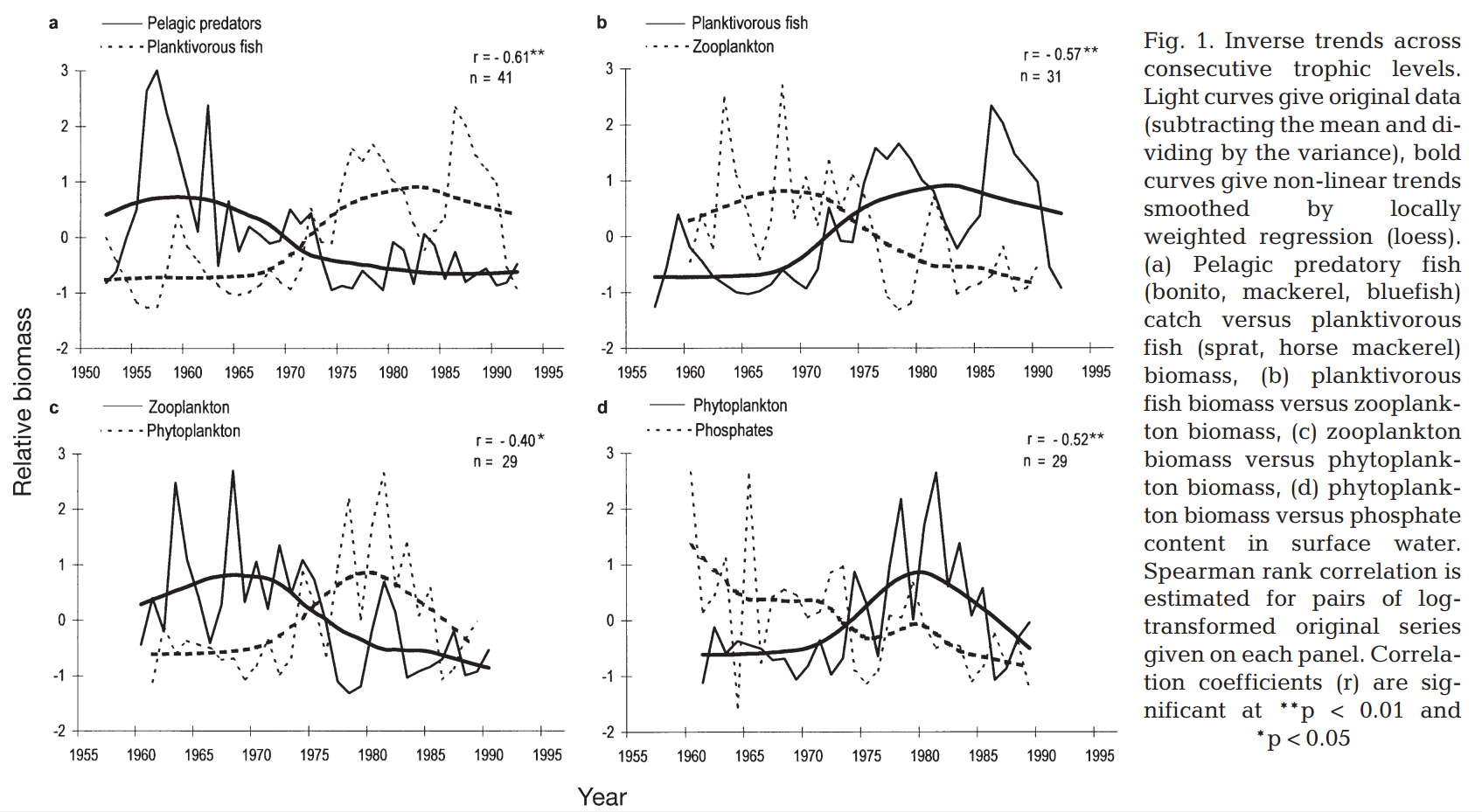
Other findings
In Lake Pohjalampi, a drop in smaller fish populations increased prey invertebrate populations.
Daniel Pauly reports that "the removal of top predators from marine ecosystems has effects that cascade down, leading to the increase of jellyfish and other gelatinous zooplankton".
Complications
Are lower populations due to predation good or bad?
Is population size alone a sufficient proxy for amount of suffering? Maybe if prey have more predators and hence smaller populations, they'll also become more r-selected and therefore have shorter lives and more total offspring? Or maybe this kind of effect would take a long time to happen, in which case it can be basically ignored given that animal live on Earth may not be around beyond a few centuries from now if Earth's dominant life forms become digital.
In a scenario where a killed animal is instantaneously replaced by another one, killing an animal prior to old age increases the number of deaths per unit time, which is bad. But in the case of fisheries, caught fish are not instantaneously or even quickly replaced, so this concern is probably not very relevant. Indeed, if the effects of fishing were applied consistently and sustainably, then the observed shifts in trophic distributions due to fishing would represent new stable population levels—in which case some fish who got killed prematurely by fisherpeople would never be replaced.
Herbivory and omnivory
Probably herbivorous fish are generally good, because they consume food that would otherwise be eaten by more numerous zooplankton. If so, then fishing herbivorous fish is bad, fishing their predators might be good, fishing the predators of those predators might be bad, and so on.
It seems that many small fish are omnivores, which makes the analysis more complex.